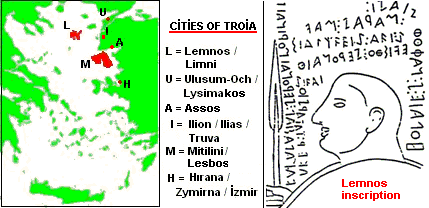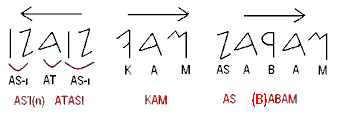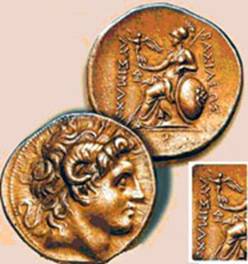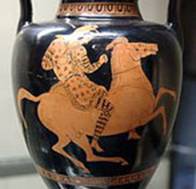|
The
cities on the coast of the Aegean Sea have been important
cultural centers during the Bronze Age which started around
3300 BC and lasted until the fall of Troia. There is a big
misunderstanding about Troia. Let mi immediately mention that
this name is of Turkic origin and means
Tur-öyü “the region of
the Tur people”. Tur-öyü became Troia because the sound “u”
did not exist in the Greek language. Helmut Uhlig says
(1):
In the region of western Anatolia, or anywhere else, a city
called Troia never existed. This city was known as Ilion or
Ilias in Greek and therefore the epic was named Iliada by
Homeros. Troia was the name of the region given by the
inhabitants who defined themselves as ‘living in Troia’.
Heroes like Hektor and Priamos were the leaders of this city.
It was
mentioned before in Chapter 31,
Hittite and Sumerian,
that “il” means “city / land” in modern Turkish and is a root
word in the Proto-language. Therefore, Ilias becomes
meaningful when split as
Ili-As
“the city of the As”. The Turkish version would rather be
“As-ili” instead of Ili-As but this transposition does not
affect its meaning. We already saw that “As” refers to the
Asiatic tribes and “on” means the universe (region) in the
Proto-language (2).
The two hero names are also meaningful when split into their
constituent phonemes. Hektor is no other than
Okh-Tur, “the
Okh-Tur”; again we find a transposition from Tuk-Okh (turk)
and Priamos becomes meaningful when split as
Bir-im-iz “one of us”,
where the original “b” sound changed to “p” and the suffix –iz
became –os. “Bir” became “Pri” and “Pro” in the Greek
pronunciation. It is interesting to note that these names have
no meaning in the Greek language. But ancient original names
were always meaningful. If we find a name without any meaning
we can immediately conclude that it is a borrowed name whose
real meaning is forgotten.
Troia
(Ilion) was conquered on 1180 BC but archeological research
has uncovered several underlying layers of settlement dating
back to 3,000 BC. The city was known as Willion by the
Hittites. The initial W is no other than an extended U
(double-u), which comes from “ulu” (holy or sacred)
(3).
Therefore, Ulu-ili-on
“the sacred universal city” became Willion and later on
changed to Filion and Ilion.

The
north-western Anatolian Troia region with its main ancient
cities is shown on the map above. Not far from Ilias / Ilion
is the ancient city of Assos, meaning As-is “belongs to the
As”. Aristotle (384 BC – 322 BC) lived in Assos for a certain
time, but Assos existed long before the 4th century
BC.
On the
island of Lemnos (above-right) an inscription was found which
is still not deciphered until today
(4).
This is because scholars tried to decipher it with the help of
Greek and Latin without any success. As they could not find
any meaning using these languages they decided that it must be
Etruscan; a language still not deciphered. We saw that
Etruscan can be understood with the help Turkish (see Chapters
9 and 10).
The Lemnos
script does not follow a given direction but is written in the
Boustrophedon style, where the first line is written from
right to left, the next line from left to right going in the
opposite direction, crisscrossing the page. Below is my own
interpretation which starts from the upper-right word and
moves downwards in the opposite direction, from left to right.
The first
three words are shown below and their decipherment has been
carried out using the Orhun characters (see Chapter 21,
The Orhun script).
Starting from the top-right end we can read the first word
As-ý Atasý “the
ancestor of the As”. We would say “As’ýn atasý” in today’s
modern Turkish. This word stands by its own as a heading,
addressing the person whose figure is engraved.
Next line
should be read from left to right as
Kam As Abam “The
shaman father of the As”. The word for “my father” is “babam”
in Turkish, but could also be pronounced as “aba” or “apa”
depending on different cultures. It became “papa” or “pater”
in Greek and Latin. We could decipher the whole text in this
manner but without going in further detail, we conclude that
this inscription from the Lemnos Island becomes meaningful
when tackled with the help of the ancient Orhun alphabet and
the Turkish language.

Another
ancient city of Troia is a settlement known as Lysimakheia,
shown with the letter U on the map above
(5).
This name can be expanded as
Ulu-As-im-Okh-öyü, meaning “the region of my holy
As and Och”. A coin found in this site shows a man wearing ram
horns on the recto and a shaman woman on the verso.

The woman is
most probably Athena, Asena or
As-Ana “the As
mother”. The winged figurine in her right hand is a clear
indication of her shamanic powers. There is also an arrow
pointing upwards indicating mystical flights towards the sky
(enlarged picture). The word “Basileos” seen on the coin means
“our ruler” or “our father / ancestor” since “Gios Basilis”
means “father Christmas” in Greek.
Basili is also
meaningful in Turkish when split as
Bas-ili “the
controller (ruler) of the region” (ili basan). This word
changed to “Vassal”, a subordinate leader indicating that the
ruler of the region was under the protection of a powerful
king.
The Lesbos
island (Mitilini) was the location of the Amazon female
warriors. Herodotus claimed that they were speaking the same
language as the Scythians. The etymology of Amazon is clearly
Ama-As-On “the
universal As mother”. It is known that they founded many towns
on the coasts of Anatolia. Amongst them are Smyrna, Ephesus,
Sinope and Paphos. The original name of Smyrna was
Hýr-Ana meaning
“virgin mother”. “Hýr” is the Chuvash form of “kýz” meaning
“virgin girl”. This name suffered the following
transformations: Hýr-Ana =>
Zmýrana =>
Smyrna =>
Ýzmir.
In order to
prevent their race from dying out, the Amazons raided the
neighboring tribes once a year in order to have sexual
relationship with men. The rest of the time they remained on
Lesbos and enjoyed each others company. This is how the female
homosexuality became to be known as lesbianism. Amazons were
great fighters and expert horse riders. Below we see a vase
with an Amazon rider in Scythian costume.
 |